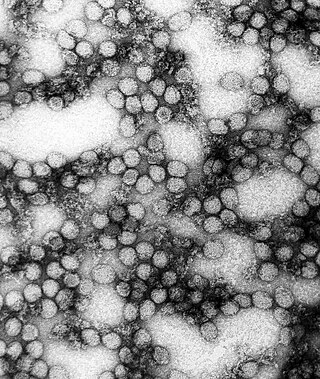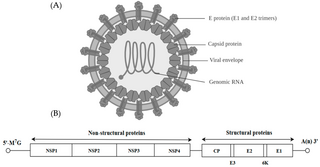
An RNA virus is a virus—other than a retrovirus—that has ribonucleic acid (RNA) as its genetic material. The nucleic acid is usually single-stranded RNA (ssRNA) but it may be double-stranded (dsRNA). Notable human diseases caused by RNA viruses include the common cold, influenza, SARS, MERS, COVID-19, Dengue Virus, hepatitis C, hepatitis E, West Nile fever, Ebola virus disease, rabies, polio, mumps, and measles.

Flaviviridae is a family of enveloped positive-strand RNA viruses which mainly infect mammals and birds. They are primarily spread through arthropod vectors. The family gets its name from the yellow fever virus; flavus is Latin for "yellow", and yellow fever in turn was named because of its propensity to cause jaundice in victims. There are 89 species in the family divided among four genera. Diseases associated with the group include: hepatitis (hepaciviruses), hemorrhagic syndromes, fatal mucosal disease (pestiviruses), hemorrhagic fever, encephalitis, and the birth defect microcephaly (flaviviruses).

Flavivirus, renamed Orthoflavivirus in 2023, is a genus of positive-strand RNA viruses in the family Flaviviridae. The genus includes the West Nile virus, dengue virus, tick-borne encephalitis virus, yellow fever virus, Zika virus and several other viruses which may cause encephalitis, as well as insect-specific flaviviruses (ISFs) such as cell fusing agent virus (CFAV), Palm Creek virus (PCV), and Parramatta River virus (PaRV). While dual-host flaviviruses can infect vertebrates as well as arthropods, insect-specific flaviviruses are restricted to their competent arthropods. The means by which flaviviruses establish persistent infection in their competent vectors and cause disease in humans depends upon several virus-host interactions, including the intricate interplay between flavivirus-encoded immune antagonists and the host antiviral innate immune effector molecules.

Arbovirus is an informal name for any virus that is transmitted by arthropod vectors. The term arbovirus is a portmanteau word. Tibovirus is sometimes used to more specifically describe viruses transmitted by ticks, a superorder within the arthropods. Arboviruses can affect both animals and plants. In humans, symptoms of arbovirus infection generally occur 3–15 days after exposure to the virus and last three or four days. The most common clinical features of infection are fever, headache, and malaise, but encephalitis and viral hemorrhagic fever may also occur.

The hepatitis C virus (HCV) is a small, enveloped, positive-sense single-stranded RNA virus of the family Flaviviridae. The hepatitis C virus is the cause of hepatitis C and some cancers such as liver cancer and lymphomas in humans.
GB virus C (GBV-C), formerly known as hepatitis G virus (HGV) and also known as human pegivirus – HPgV is a virus in the family Flaviviridae and a member of the Pegivirus, is known to infect humans, but is not known to cause human disease. Reportedly, HIV patients coinfected with GBV-C can survive longer than those without GBV-C, but the patients may be different in other ways. Research is active into the virus' effects on the immune system in patients coinfected with GBV-C and HIV.

Alphavirus is a genus of RNA viruses, the sole genus in the Togaviridae family. Alphaviruses belong to group IV of the Baltimore classification of viruses, with a positive-sense, single-stranded RNA genome. There are 32 alphaviruses, which infect various vertebrates such as humans, rodents, fish, birds, and larger mammals such as horses, as well as invertebrates. Alphaviruses that could infect both vertebrates and arthropods are referred dual-host alphaviruses, while insect-specific alphaviruses such as Eilat virus and Yada yada virus are restricted to their competent arthropod vector. Transmission between species and individuals occurs mainly via mosquitoes, making the alphaviruses a member of the collection of arboviruses – or arthropod-borne viruses. Alphavirus particles are enveloped, have a 70 nm diameter, tend to be spherical, and have a 40 nm isometric nucleocapsid.

Hepacivirus is a genus of positive-strand RNA viruses in the family Flaviviridae. The hepatitis C virus (HCV), in species Hepacivirus C, infects humans and is associated with hepatitis and hepatocellular carcinoma. There are fourteen species in the genus which infect a range of other vertebrate.

Sir Arnold Theiler KCMG Pour le Mérite is considered to be the father of veterinary science in South Africa. He was born in Frick, Canton Aargau, Switzerland. He received his higher education, and later qualified as a veterinarian, in Zurich. In 1891, Theiler travelled to South Africa and at first found employment as a farm worker on Irene Estates near Pretoria, owned by Nellmapius, but later that year started practising as a veterinarian.
Non-A-E hepatitis, also known as hepatitis X, is an infectious disease of the liver referring to a case of viral hepatitis that cannot be attributed to hepatitis A, B, C, D, or E. The disease involves swelling and inflammation of the liver. Symptoms of non-A-E hepatitis may include tiredness, nausea, vomiting, abdomen pain, and a fever. The specific cause of non-A-E hepatitis is unknown. It is considered a rare disorder.

Hepatitis B virus (HBV) is a partially double-stranded DNA virus, a species of the genus Orthohepadnavirus and a member of the Hepadnaviridae family of viruses. This virus causes the disease hepatitis B.
Hepacivirus A, or Canine hepacivirus (CHV) or Equine hepacivirus (EHV), is a positive-sense single-stranded RNA virus of the genus Hepacivirus. It infects dogs and horses, and causes pulmonary infections in dogs. Unlike the related Hepatitis C virus, it is not known to cause hepatitis in either host.

Betacoronavirus is one of four genera of coronaviruses. Member viruses are enveloped, positive-strand RNA viruses that infect mammals. The natural reservoir for betacoronaviruses are bats and rodents. Rodents are the reservoir for the subgenus Embecovirus, while bats are the reservoir for the other subgenera.

Human coronavirus 229E (HCoV-229E) is a species of coronavirus which infects humans and bats. It is an enveloped, positive-sense, single-stranded RNA virus which enters its host cell by binding to the APN receptor. Along with Human coronavirus OC43, it is one of the viruses responsible for the common cold. HCoV-229E is a member of the genus Alphacoronavirus and subgenus Duvinacovirus.
Equine pegivirus (EPgV) is a virus in the genus Pegivirus of the family Flaviviridae. It was discovered in 2013 in blood of horses and causes chronic infections. EPgV is not known to be responsible for any disease in horses. In a serosurvey of EPgV and related viruses, antibodies to EPgV were detected in the majority of horses, indicating a high prevalence in them.
Hepatitis C virus (HCV) genotypes refer to the genetic variations that occurs in the hepatitis C virus. Hepatitis C is a contagious disease that primarily affects the liver, causing severe damage as the disease progresses. It is caused by the Hepatitis C virus, a small, enveloped RNA virus. The transmission of hepatitis C is through the contact with the blood of the infected person, for example by sharing the needles or by using non-sterile medical equipment. HCV is transmitted globally because of the high infection rate and is also associated with a high mortality rate. The World Health Organization indicates the 3.3% of the world population is infected by the HCV virus. Statistical records show that there are about 13 million HCV affected persons in Сhina, 3.5 million affected persons in the United States, and about 10 million people are affected by HCV in Pakistan. In all cases, the viral genotype of the HCV stays the same, occasionally mutations do occur making the treatment more complex by targeting the changes in the genotype. Hepatitis C virus genotype is considered more common than the Hepatitis B virus infection contributing to more than a million cases annually and is considered one of the major reason for liver transplantation in United States. Some of the HCV genotypes may develop in people without symptoms leading to dangerous conditions like liver cirrhosis causing a permanent damage to liver and the unnoticed HCV conditions will affect brain, joints, blood vessels, bones, and kidneys.
HPgV-2 is the second human pegivirus discovered. It was first identified in 2005 in blood of transfusion recipients and initially named hepegivirus 1 because it shared some genetic features with both pegiviruses and hepaciviruses. HPgV-2 was later independently discovered by another group in the blood of a HCV-infected patient who had undergone multiple blood transfusions and died from sepsis of unclear etiology. It was then named human pegivirus 2. HPgV-2 is now classified in the pegivirus genus as part of Pegivirus H species.

The history of coronaviruses is an account of the discovery of the diseases caused by coronaviruses and the diseases they cause. It starts with the first report of a new type of upper-respiratory tract disease among chickens in North Dakota, U.S., in 1931. The causative agent was identified as a virus in 1933. By 1936, the disease and the virus were recognised as unique from other viral disease. They became known as infectious bronchitis virus (IBV), but later officially renamed as Avian coronavirus.
Francis "Frank" Vincent Chisari is a physician, experimental pathologist, virologist, and immunologist, known for his research on virus-host interactions of hepatitis B and hepatitis C.
Kedougou virus (KEDV) is an arbovirus of the Flaviviridae family, genus Flavivirus, belongs to the IV group of a viruses. The virus was first isolated from Aedes minutus mosquitoes in Senegal in 1971. KEDV belongs to the Kedougou virus group. It is endemically present in the Kédougou Region, from which it takes its name, together with other arboviruses of the genus Flavivirus such as: Yellow fever virus (YFV), West Nile virus (WNV) and Zika virus (ZIKV). KEDV has also been isolated from Aedes circumluteolus mosquitoes collected in Ndumu, KwaZulu-Natal, South Africa.













